Possible ID: Coprinellus micaceus
Classification:
Phylum: Basidiomycota
Class: Agaricomycetes
Order: Agaricales
Family: Psathyrellaceae
Genus: Coprinellus
Collection location:
Coprinellus micaceus is a very common and widely distributed fungus in North America.1 The first fungal sample was collect from a dense gregarious cluster of mushrooms on the ground approximately 10 meters away from a hardwood tree along Moore Avenue near the ELC at Bucknell University on May 1st, 2018, which was a nice, clear, sunny day.
Sample site pictures on May 1st, 2018:
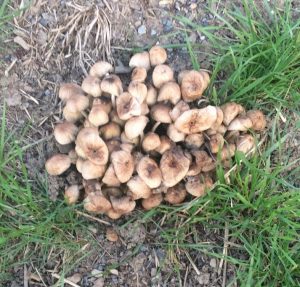
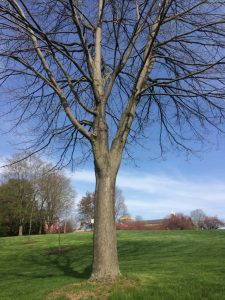
Because this sample was observed to have deliquesced into a black inky fluid a few days later, four more samples from the same cluster of mushrooms were collected on May 6th, 2018. However, in contrast to the first sample day, the weather on this day was overcast and rainy.
Picture of the fruiting body of the first sample deliquescing:
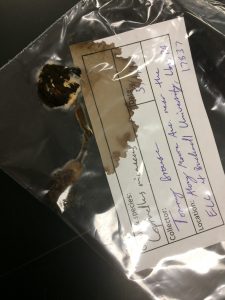
One of the fruiting bodies taken from the sample site on May 6, 2018:
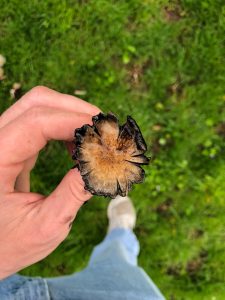
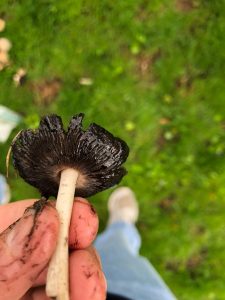
Fruiting body appearance and growth:
Collected fruiting bodies had flesh that was pretty thin. Consequently, they were very fragile and broke fairly easily when handling. Likewise, the hollow stipes were also pretty thin and fairly brittle. Stipes were off-white to slightly tannish in color and measured between 4-7 mm in diameter. In addition, stipes of the fungal samples remained relatively constant in diameter throughout their lengths. Towards the pileus, the fibrous stipes were rather smooth and silky but got progressively more granular towards the base. No universal or partial veils were observed in these specimens.
Additionally, collected fruiting bodies also presented umbrella-like pilei that were a tannish to orange-ish tawny-brown color, which grew darker towards the center of the caps. Shapes of the pilei of the fruiting bodies were extremely variable as they were conic to convex to campanulate and umbonate to even depressed in the one sample. This variability in cap morphology resulted from the differences in the ages of the caps since the pilei of the Coprinellus micaceus fruiting bodies will become more broadly convex or bell-shaped as they grow older.1,2 Pilei of the fruiting body samples were also striated and had plicate-striate margins. Although the first sample displayed a curled-up, involuted margin, the wet ones exhibited margins that were upturned. Caps from the second set of samples ranged from 1-2.5 cm in height and were around 4-4.5 cm in width.
The caps of young Coprinellus micaceus fruiting bodies are usually covered in tiny white granules that will glisten when light is shined upon them.1-3 These particles are in fact remnants of the universal veil that will tend to disappear with age.2,3 Unfortunately, these glistening particles were not observed in any of these specimens. Because these fruiting bodies were relatively mature, it is very likely that these granules had been washed off of these specimens by rain or even the morning dew before they were collected.1-3
Moreover, fungal specimens consisted of gills that were dark purplish to black in color. Although they appeared to be free at first, the gills were actually observed to be adnexed upon closer examination as they were narrowly attached to the stipe. Gills were crowded very closely together, and gills from the second set of samples seemed to exude a black, ink-like substance. Interestingly, gills of Coprinellus micaceus fruit bodies will start out as white, but will then progressively get darker before eventually deliquescing, that is, digesting itself and turning itself into a black, ink-like fluid.1-3
Coprinellus micaceus is a saprobic, white-rot fungus that grows in dense clusters on or near decaying hardwood.1-3 As observed in these fungal specimens, fruiting bodies are caespitose, meaning that they are joined together with one another at the base of their stipes.3 Moreover, fruiting bodies of Coprinellus micaceus may appear to be terrestrial if their substrate is a rotting underground tree root or wood that is buried underground.1-3 Because these fungal specimens were found near a hardwood tree, it is likely that the dense gregarious cluster of Coprinellus micaceus mushrooms were growing underground from one of the hardwood tree’s dead roots.
*On a side note, even though Coprinellus micaceus is edible,1-3 I decided not to try it.
Pictures of the first specimen:

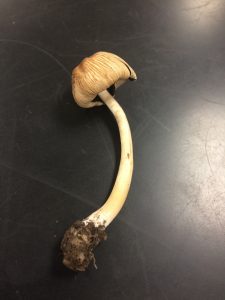
Pictures of the second set of samples:

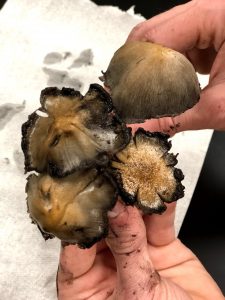
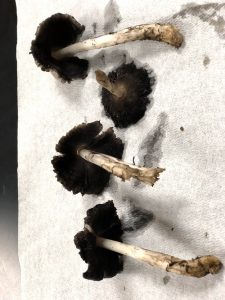
Spore production:
As soon as mature Coprinellus micaceus fruiting bodies begin releasing their spores, they will begin to release chitinases that will break down and digest themselves through a process known as deliquescence.1-4 This process of degrading themselves into an inky black substance is an identifying characteristic of inky cap fungi, and this self-sacrificing mechanism of the parent for the offspring assists in spore dispersal by curling back the crowded gills, creating more space between them and better exposing them to wind currents.4,5 After releasing their spores, Coprinellus micaceus fruiting bodies will produce a dark brownish black to black spore print.1-3 Spores appear smooth and are elliptical to mitriform in shape, measuring around 7-11 x 3.5-7 µm.1-3 Spores will also sport an apical germ pore.1-3
Collector: Tommy Brouse Group: Andriana, Tommy, AJ
References
1http://www.mushroomexpert.com/coprinellus_micaceus.html
2https://www.first-nature.com/fungi/coprinellus-micaceus.php
3Miller, O. & Miller, H. (2006). North American mushrooms: A field guide to edible and inedible fungi. FalconGuide: Morris Book Publishing, LLC. Guilford, CT: The Globe Pequot Press.
4https://blog.mycology.cornell.edu/2008/07/01/the-dish-on-deliquescence-in-coprinus-species/
5http://www.mushroomexpert.com/coprinoid.html